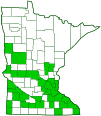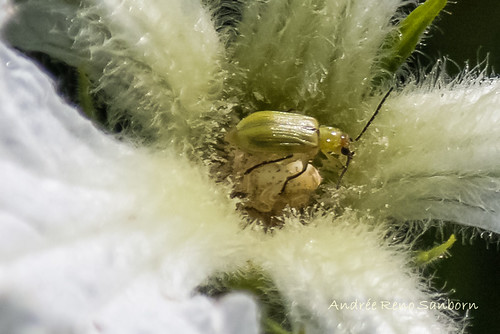northern corn rootworm beetle
(Diabrotica barberi)
Conservation • Description • Habitat • Ecology • Distribution • Taxonomy
Conservation Status |
|
|||||||
| IUCN Red List | not listed |
|||||||
| NatureServe | NNR - Unranked |
|||||||
| Minnesota | not listed |
|||||||
Description |
||
Northern corn rootworm beetle is a small skeletonizing leaf beetle. The body is 3 ⁄16″ to ¼″ long, moderately elongated, and moderately flattened. When viewed from above, the head and most of the legs are clearly visible. Newly emerged adults are cream-colored to light brown, soon turning greenish-yellow. The mouthparts project from the front of the head. The base of the antennae are close together, about level with the middle of the eyes. The antennae are flexible, and can project in various directions. The pronotum is pale greenish-yellow and narrower than the elytra. It has a pair of depressions and a distinct lateral margin. The elytra are pale greenish-yellow and hairless, with distinct, longitudinal, parallel ridges. They do not have stripes or spots. When viewed from above, the third leg segment (femur) is greenish-yellow, never black or lined with black. The last part of each leg (tarsus), corresponding to the foot, has five segments but the fourth segment is minute, making it appear that there are only four segments. |
||
Size |
||
Total length: 3 ⁄16″ to ¼″ |
||
Similar Species |
||
Habitat |
||
Corn fields and adjacent areas |
||
Ecology |
||
Season |
||
Mid-July to late September |
||
Behavior |
||
|
||
Life Cycle |
||
Adults emerge from mid-July to late August. They are most active at dawn and dusk. The female deposits its eggs in the soil within 6″ of the soil surface at the base of a corn plant. It may live up to 80 days and deposit up to 1,000 eggs. The eggs overwinter in the soil. They hatch in early to late June. Young larvae feed on fine rootlets, older larvae invade the root core. They pupate in the soil within 4 to 6 weeks, and emerge as adults 5 to 10 days later. |
||
Larva Food |
||
Roots of corn (Zea mays) |
||
Adult Food |
||
Mostly leaves and silk of corn (Zea mays); also plants of the Poaceae (grass), Asteraceae (aster), Fabaceae (pea), and Cucurbitaceae (gourd) families . |
||
Distribution |
||||
|
Sources 7, 24, 27, 29, 30, 82. |
|||
| 8/15/2022 | ||||
Occurrence |
||||
Common. Major pest on corn crops. |
||||
Taxonomy |
|||
Order |
Coleoptera (Beetles) | ||
Suborder |
Polyphaga (Water, Rove, Scarab, Long-horned, Leaf, and Snout Beetles) | ||
Infraorder |
Cucujiformia | ||
Superfamily |
Chrysomeloidea (leaf beetles and allies) | ||
Family |
Chrysomelidae (leaf beetles) | ||
Subfamily |
Galerucinae (skeletonizing leaf and flea beetles) | ||
Tribe |
Luperini | ||
| Subtribe | Diabroticina | ||
| Section | Diabroticites | ||
Genus |
Diabrotica | ||
Synonyms |
|||
Diabrotica longicornis barberi |
|||
Common Names |
|||
northern corn rootworm (larva) northern corn rootworm beetle |
|||
Glossary
Elytra
The hardened or leathery forewings of beetles used to protect the fragile hindwings, which are used for flying. Singular: elytron.
Femur
In insects, the largest, most robust segment of the leg, coming immediately before the tibia. In humans, the thigh bone.
Pronotum
The exoskeletal plate on the upper side of the first segment of the thorax of an insect.
Tarsus
On insects, the last two to five subdivisions of the leg, attached to the tibia; the foot. On spiders, the last segment of the leg. Plural: tarsi.
Visitor Photos |
|||||
Share your photo of this insect. |
|||||
| This button not working for you? Simply email us at info@MinnesotaSeasons.com. Attach one or more photos and, if you like, a caption. |
|||||
Alfredo Colon |
|||||
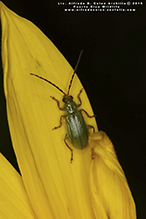 |
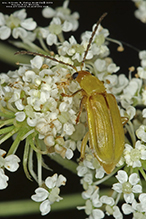 |
||||
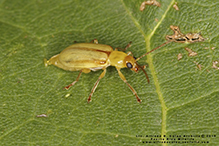 |
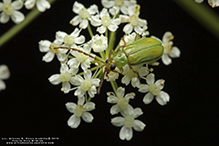 |
||||
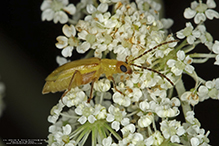 |
|||||
MinnesotaSeasons.com Photos |
|||||
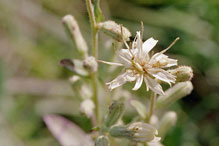 |
|||||

Visitor Videos |
|||
Share your video of this insect. |
|||
| This button not working for you? Simply email us at info@MinnesotaSeasons.com. Attach a video, a YouTube link, or a cloud storage link. |
|||
Other Videos |
|||
| Scouting for Adult Corn Rootworm in Field Corn NDSUExtension |
|||
About
Published on Nov 11, 2013 In this video, NDSU Extension Entomologist, Dr. Janet Knodel,discusses how to scout for corn rootworm adults during pollination in field corn, and how to make pest management decisions when adult populations are high. Scouting tips are described including how to identify northern and western corn rootworms and the economic threshold for adult corn rootworms. NDSU Extension Website: http://www.ag.ndsu.edu/extensionentomology North Dakota Field Crops Insect Management Guide: |
|||


Last Updated:
